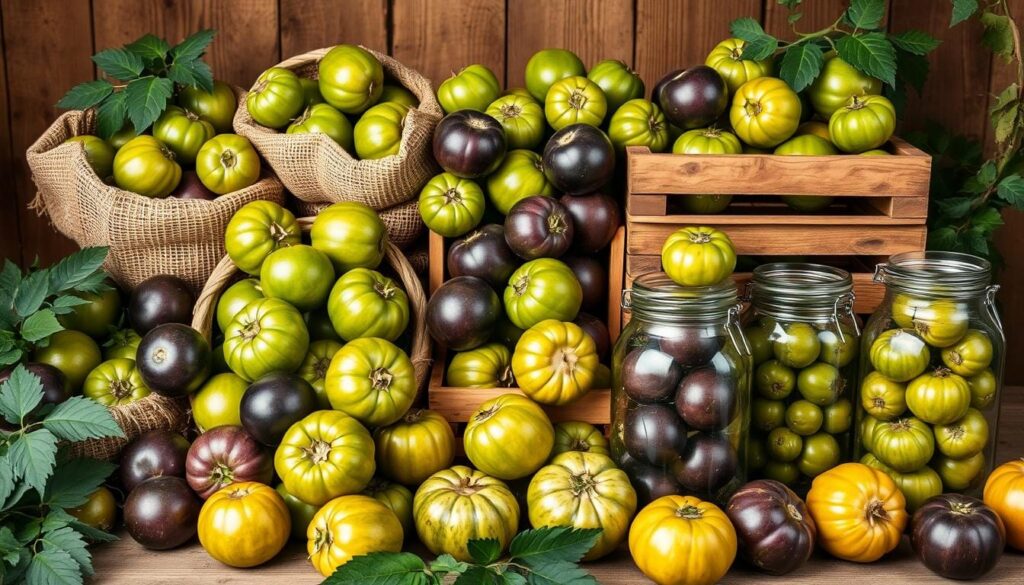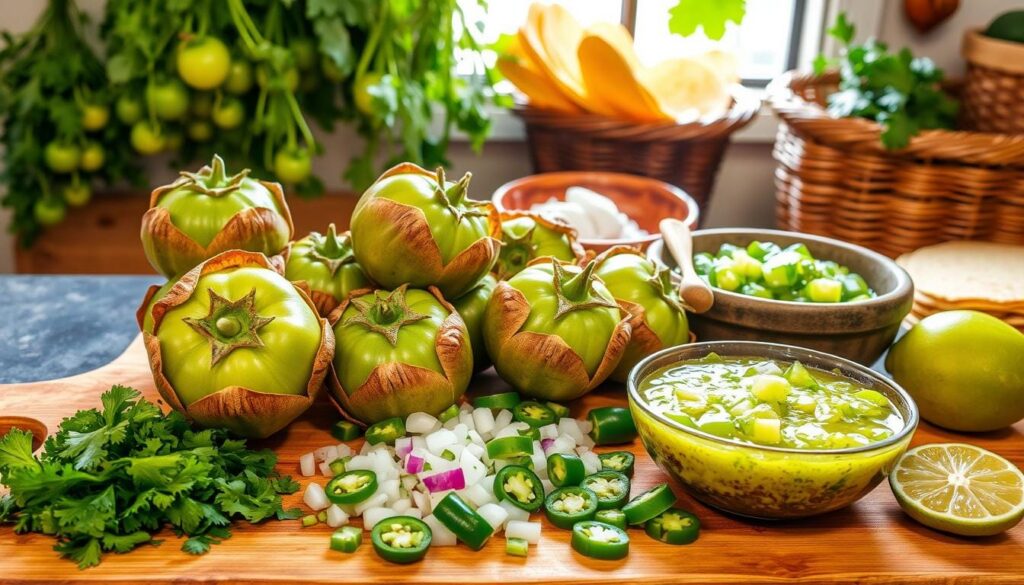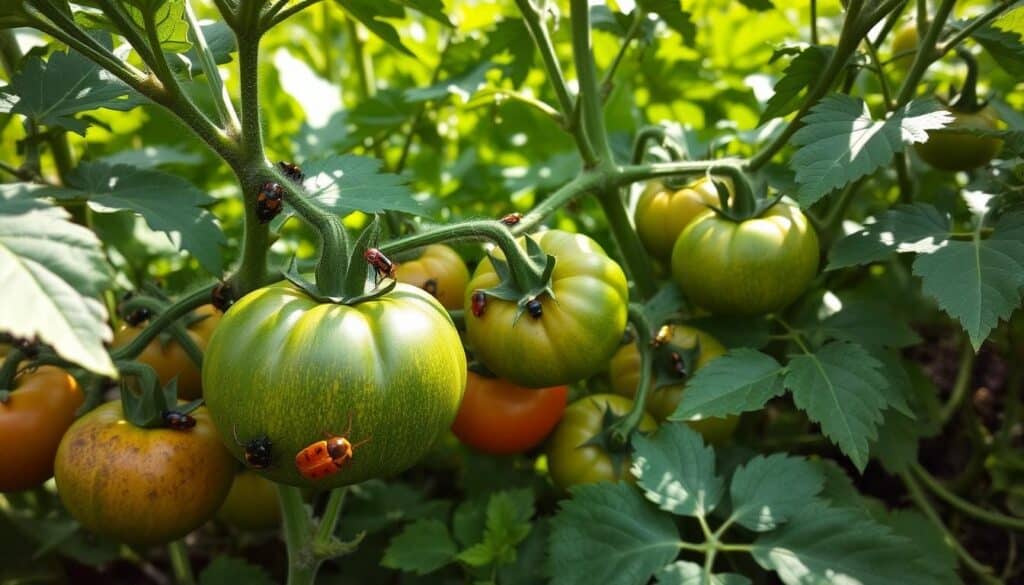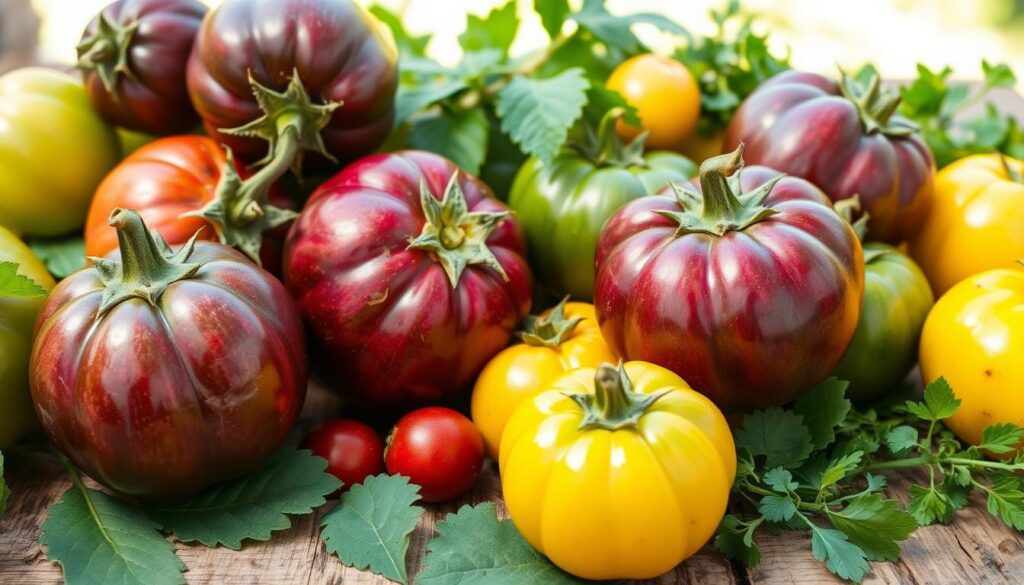Every summer, our garden turns into a magical place with green husks and promising fruit. When I first learned to harvest tomatillos, I saw it as more than picking fruit. It’s about understanding the balance between patience and precision.
Tomatillo harvest time is very important. These fruits, from Mexico, need careful attention to get them at their best. Our guide will show you how to pick these fruits perfectly from your garden.
Knowing how tomatillos grow is essential for a good harvest. They need at least two plants for pollination. This means we must plan our garden carefully. Each plant can give a lot of fruit, making them a great choice for any garden.
Key Takeaways
- Tomatillos require multiple plants for successful pollination
- Harvest timing is critical for the best flavor
- Look for fully developed, green husks as a ripeness indicator
- One plant can produce a lot of fruit
- Proper harvesting prevents a soapy taste in overripe fruits
Understanding Tomatillos and Their Growth Cycle
Exploring tomatillos can be exciting for gardeners and food lovers. These fruits are more than a Mexican dish staple. They are interesting plants with a growth cycle that needs careful care.
What Are Tomatillos?
Tomatillos are part of the nightshade family, like tomatoes. Physalis ixocarpa and Physalis philadelphica are the main types grown. They have papery husks and green to purple fruits with a tangy taste.
- Height: 3-4 feet tall
- Width: Equally wide (3-4 feet)
- Growing season: Warm-season crop
The Life Cycle of Tomatillos
Knowing the tomatillo growing season is key for growing them well. These plants love warm weather, 70-80°F, and slightly acidic soil (pH 6.0-7.0). Our care plan focuses on each stage of growth.
“Tomatillos are like little green jewels waiting to reveal their full in your garden!” – Gardening Enthuasiast
| Growth Stage | Key Requirements |
|---|---|
| Seed Germination | Soil temperature 80°F, 4-6 seeds planted ½-inch deep |
| Transplanting | 5-7 leaves, 6-10 inches tall, space 2 feet apart |
| Fruit Development | 6+ hours direct sunlight, 1-2 inches water per week |
We suggest planting at least two tomatillo plants for cross-pollination. With proper care, each plant can produce 2-3 pounds of fruit. The growing season usually lasts until the first frost.
Signs of Ripeness in Tomatillos
Figuring out when tomatillos are ready can be hard. Our guide will teach you how to spot ripe tomatillos with ease.
Watching tomatillos ripen needs close attention. They go through clear stages that show they’re ready to pick.
Color Indicators: Green vs. Purple
Tomatillos change color as they ripen, showing their variety. Green ones turn from bright lime to yellow-green. Purple ones get a deep, rich color.
- Green tomatillos: Bright lime to pale green
- Purple tomatillos: Light green to deep purple
- Optimal harvest color: Firm, bright green
Wrinkled Husk: When to Take Notice
The husk around tomatillos is key to knowing when they’re ripe. Garden experts say to look for these signs:
| Husk Condition | Ripeness Indication |
|---|---|
| Bright green and tight | Unripe, not ready |
| Turning tan, splitting | Ready for harvest |
| Completely dried | Overripe |
Pro tip: Squeeze the tomatillo gently. A ripe one will feel firm but slightly soft, showing it’s time to pick.
The secret to perfect tomatillos? Timing is everything!
Timing Your Harvest
Growing tomatillos needs careful planning and knowing their unique harvest cycle. Our guide will teach you how to time your tomatillo harvest for the best yield and flavor.
Best Time of Year to Harvest Tomatillos
Knowing when to harvest tomatillos is key for gardeners. The best time is from mid-summer to autumn. Peak production is usually between July and October.
- Mid-summer to autumn: Primary harvest window
- Early morning: Best time for picking
- Every few days: Recommended harvesting frequency
How Long Does It Take for Tomatillos to Mature?
Patience is essential when growing tomatillos. They take 75 to 100 days from transplanting to harvest. Knowing their growth cycle helps plan planting.
“Timing is everything in tomatillo cultivation – know your plant’s rhythm!”
Tomatillo plants are very productive, yielding 64 to 200 fruits per season. To harvest successfully, follow these strategies:
- Plant at least two tomatillo plants for proper pollination
- Space plants approximately 3 feet apart
- Provide consistent water (1-1.5 inches weekly)
- Monitor fruits every few days
Tomatillo plants fruit continuously, giving you multiple harvests. Look for a full, bursting husk and fruits 2-3 inches in diameter to know it’s time to pick!
Tools and Techniques for Harvesting
Picking tomatillo fruits needs careful attention and the right tools. Our guide will help you master tomatillo plant care for a successful harvest.
Understanding the right tools and techniques is key to successful tomatillo harvesting. Our gardeners emphasize gentle handling to preserve both the fruit and the plant’s health.
Essential Harvesting Tools
- Sharp pruning scissors
- Gardening gloves
- Small harvest basket
- Clean, soft cloth for wiping fruits
Proper Harvesting Techniques
Follow these critical steps when picking tomatillo fruits:
- Check the husk for signs of dryness and splitting
- Gently twist the fruit to test ripeness
- Use pruners to cut fruits that don’t easily detach
| Harvesting Indicator | Action |
|---|---|
| Husk turns papery | Ready to harvest |
| Fruit feels firm | Perfect picking time |
| Fruit drops naturally | Overripe, collect immediately |
“Treat your tomatillo plants like delicate friends – gentle touches ensure the best harvest.”
Tomatillo plant care goes beyond harvesting. Always handle plants carefully to encourage continued production. Harvesting is usually 75 to 100 days after planting, best in the morning.
Pro tip: Wear gloves to protect your hands from the sticky residue often found on tomatillo husks.
Impact of Weather on Harvesting
Weather is key to a successful tomatillo growing season. Knowing how weather affects tomatillo care can lead to a great harvest or a poor one.
Navigating Temperature Challenges
Tomatillo plants do best in certain temperatures. They love it when it’s around 25 degrees Celsius (77°F). The soil should be between 19-23 degrees Celsius for optimal growth. But, extreme heat can be a big problem:
- Temperatures over 35 degrees Celsius (95°F) can warp the fruit
- High heat can hurt the flowers
- It can also cut down on fruit production
Harvesting Before Frost: Critical Timing
Tomatillo plants are very sensitive to cold. We must watch out for frost to protect our crop. If it gets too cold, below 10 degrees Celsius (50°F), we need to cover them.
“Timing is everything when protecting your tomatillo harvest from unexpected cold snaps.”
Watering Strategies for Different Weather Conditions
Good tomatillo care means adjusting how we water. Plants need steady moisture during the growing season:
| Weather Condition | Watering Recommendation |
|---|---|
| Sunny Days | Daily watering, up to 2 liters per plant |
| Moderate Temperature | 1-1.5 inches of water per week |
| High Heat | Water more often, check soil moisture |
Tomatillo plants take 60-80 days to grow. Managing the weather is vital during this time. By understanding and adapting to the weather, we can ensure a good harvest and protect our plants.
Storing Harvested Tomatillos
After taking care of your tomatillo plants, it’s important to store them right. This helps keep their flavor and freshness. Knowing how to store them properly is key.

When it’s time to harvest tomatillos, it’s important to store them well. This way, you can enjoy them for a longer time. Here are some tips for storing them:
Optimal Storage Conditions
- Keep tomatillos in their papery husks during storage
- Store at temperatures between 55°F to 60°F
- Maintain 85-90% humidity for maximum freshness
- Use a loose, unsealed paper bag in the refrigerator
How Long Can We Keep Them Fresh?
With good care, your tomatillos can last longer. Fresh tomatillos can last 2-3 weeks when stored right. The fridge is the best place to keep them.
“The key to storing tomatillos is maintaining their original condition – keep the husk on and store them cool and dry.”
Freezing for Long-Term Storage
- Remove husks
- Rinse and thoroughly dry
- Freeze in a single layer on a baking tray
- Transfer to freezer bags, removing excess air
Don’t store tomatillos near fruits like apples or bananas. They can make tomatillos ripen and spoil faster.
Common Mistakes When Harvesting
Learning when to pick tomatillos can be challenging. Even seasoned gardeners sometimes find it hard to know when to harvest. Our guide will help you understand how to tell when tomatillos are ready and avoid common mistakes.
Overripe vs. Underripe: Finding the Perfect Balance
Timing is everything when it comes to harvesting tomatillos. Green ones should be picked before they turn yellow or purple. Waiting too long can greatly affect their taste and texture. Here are some important signs to look for:
- Green tomatillos should be firm and fully grown in their husks
- Don’t pick when they start to soften or change color
- The best time to harvest is usually about 60 days after planting
Understanding Husk Condition
The tomatillo’s husk tells you a lot about its readiness. Experienced gardeners know that a tight, green husk means it’s time to pick. Look for these signs:
- Husk should be tight and green
- Fruit starts to show through the husk
- Stay away from husks that are brown or papery
“The secret to perfect tomatillos lies in understanding their subtle ripening signals.” – Garden Experts
By paying attention to these details, we can get a great harvest of tasty tomatillos. Regular checks and careful watching will help avoid common mistakes and make the most of your garden.
Creative Uses for Harvested Tomatillos
After tending to our tomatillo plants, we’ve reached harvest time. Different varieties offer unique flavors for our kitchen. This makes our cooking adventures exciting.

Our harvest brings many delicious options. Tomatillos are great in many dishes. They add a special touch to our meals.
Fresh Tomatillo Recipe Ideas
- Classic Salsa Verde
- Roasted Tomatillo Gazpacho
- Tomatillo Chicken Enchiladas
- Tangy Green Sauce for Grilling
Preserving Your Tomatillo Harvest
Preserving tomatillos lets us enjoy them all year. We use two main methods:
- Freezing: Great for future salsa
- Canning: Makes lasting condiments
| Preservation Method | Storage Duration | Best Uses |
|---|---|---|
| Freezing | 3-6 months | Salsa, Sauces |
| Canning | 6-12 months | Chutneys, Preserves |
“Tomatillos are like culinary magic – transforming from simple garden produce to extraordinary dishes!” – Local Chef
With just 7-8 tomatillos, we make a tasty salsa verde. Roasting at 500 degrees Fahrenheit brings out amazing flavors.
Expanding Our Tomatillo Garden
Growing tomatillos is a great way to increase your home garden. We’ll show you how to grow these plants well. This will help you have a great tomatillo season.
Companion Planting Strategies
Good tomatillo care means using companion planting. This helps your plants grow better. Here are some good friends for your tomatillos:
- Basil – keeps pests away
- Peppers – grow well together
- Marigolds – keep pests out
- Carrots – make the soil better
Tomatillos need two plants to make fruit. So, plant at least two varieties.
Container Gardening Techniques
Even with little space, you can grow tomatillos. Container gardening is perfect for city or small gardens.
| Container Requirements | Recommended Specifications |
|---|---|
| Minimum Container Size | 5-gallon pot |
| Soil Type | Well-draining potting mix |
| Spacing | One plant per container |
| Sunlight Needs | Full sun (6-8 hours daily) |
Pro tip: Use organic fertilizer with a 5-5-5 ratio monthly to support container-grown tomatillo plants.
“With the right care, a single tomatillo plant can produce over a hundred fruits!” – Garden Experts
By managing your containers well, you can grow tomatillos all season. This way, you can enjoy fresh tomatillos even with little space.
Troubleshooting Common Issues
Growing tomatillos can sometimes present challenges during the tomatillo growing season. Understanding these problems helps gardeners protect their crops and ensure a healthy harvest.
Pests Affecting Tomatillo Plants
While tomatillos have natural pest resistance, several insects can impact plant health:
- Aphids: These tiny insects can cause leaf discoloration and stunted growth
- Cutworms: Capable of severing young plant stems at soil level
- Slugs: Most active during damp conditions, consuming foliage at night

Diseases to Watch Out For
Our tomatillo plant care strategy must include monitoring for diseases:
- Anthracnose: Causes circular lesions that can lead to significant crop loss
- Bacterial leaf spot: Creates translucent spots, more prevalent in cooler temperatures
- Fusarium wilt: Indicated by spindly, brown roots and possible plant death
Early detection and prompt intervention are key to maintaining healthy tomatillo plants.
Preventative measures include practicing crop rotation, maintaining proper spacing between plants, and removing diseased plant debris. Using disease-resistant varieties can significantly reduce the risk of infection during the tomatillo growing season.
Regular monitoring, proper soil management, and understanding your local growing conditions will help minimize pest and disease challenges in your tomatillo garden.
Knowing When to Replant
Tomatillo plants grow and change over time. Knowing when to replant is key for a healthy garden.
Factors Indicating Replanting Needs
Here are signs it’s time to replant your tomatillo garden:
- Decreased fruit production
- Signs of plant stress or disease
- Plants reaching the end of their productive cycle
- Damage from pests or environmental factors
Timing Your Next Planting Cycle
After the harvest season ends, it’s time to plan for the next crop. We’ve found important tips for replanting:
| Replanting Factor | Recommended Approach |
|---|---|
| Indoor Start | 6-8 weeks before outdoor transplanting |
| Soil pH | 6.0 to 6.8 (optimal at 6.3-6.5) |
| Plant Spacing | 20-25% larger pot than previous season |
| Plant Count | Minimum 2 plants for cross-pollination |
Pro tip: Always monitor your plants’ health and be prepared to start new seedlings before the current plants completely decline.
“Successful gardening is about continuous learning and adaptation” – Experienced Tomatillo Grower
By following these replanting tips, we can keep our tomatillo harvest going all season.
Understanding Tomatillo Varieties
Tomatillo varieties open up a world of flavors, colors, and growing habits. Exploring tomatillo plant care starts with knowing the many varieties in the U.S.

Our exploration of tomatillo varieties shows a wide range of options. These can change your garden and kitchen for the better. Let’s look at the most interesting tomatillo types!
Popular Tomatillo Varieties in the U.S.
Tomatillo varieties are grouped by color and special traits:
- Green Tomatillos: Common, medium to large size
- Purple Tomatillos: Sweeter, with a unique color
- Yellow Tomatillos: Smaller, milder taste
Choosing the Right Variety for Our Climate
Picking the right tomatillo variety is key. It depends on several important factors:
| Variety | Size | Flavor Profile | Best Suited For |
|---|---|---|---|
| Toma Verde | Medium | Tart | Salsas, Cooking |
| Purple Hybrid | Medium | Sweet | Fresh Eating |
| Yellow Hybrid | Small | Mild | Salads, Garnishes |
When picking tomatillo varieties for our garden, think about local climate, use, and taste. Hybrid varieties often have better disease resistance and yield. They’re great for home gardeners.
Pro tip: Always plant at least two tomatillo plants to ensure successful pollination and maximum fruit production!
Knowing about tomatillo varieties helps us make better choices in gardening and cooking. Each variety adds its own special touch, promising a tasty and enjoyable experience.
The Nutritional Benefits of Tomatillos
Tomatillos are more than just a tasty ingredient in Mexican dishes. These small, green fruits are packed with nutrients that boost our health. Knowing what’s in tomatillos helps us see their value in a healthy diet.
Let’s dive into the amazing nutritional world of tomatillos. We’ll look at their key parts:
- Low in calories (32 calories per 100 grams)
- High in dietary fiber (1.9 grams per 100 grams)
- Rich in essential minerals
- Excellent source of vitamins
Health Benefits We Gain from Tomatillos
How we care for tomatillo plants affects their nutrition. When grown right, these fruits give us great health benefits:
| Nutrient | Amount per 100g | Health Benefit |
|---|---|---|
| Vitamin C | 11.7 mg | Boosts immune system |
| Potassium | 268 mg | Supports heart health |
| Magnesium | 20 mg | Enhances muscle function |
Tomatillos in a Balanced Diet
Adding different tomatillo varieties to our meals can be very beneficial. They are low in calories, making them great for weight control. With only 32 calories per 100 grams, tomatillos are a nutritious choice for healthy eating.
Tomatillos are a nutritional powerhouse that can transform your diet from ordinary to extraordinary.
By learning about tomatillos’ nutritional benefits and choosing the right ones, we can make tasty, healthy meals. These meals will nourish our bodies and please our taste buds.
Incorporating Tomatillos into Our Diet
After picking tomatillo fruits from our garden, we’re ready to explore their incredible culinary use. These green gems are key in Mexican cuisine, adding a tangy flavor to dishes. Different tomatillo varieties add unique qualities to our cooking, making them exciting to try.
Roasting tomatillos at 400°F for about 20 minutes gives them a rich, nutty taste. This is perfect for salsas and sauces. We can also blend them into classic salsa verde with onions, cilantro, and garlic for 6-8 minutes. Their flavor is great in omelets, gazpacho, or even in vibrant vinaigrettes.
Nutritionally, tomatillos are full of Vitamin A and C, supporting vision, immune function, and skin health. They’re low-calorie and rich in antioxidants, making them great for a balanced diet. Tomatillos open up endless possibilities for creative home cooking, pleasing our taste buds and boosting our health.

